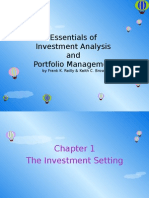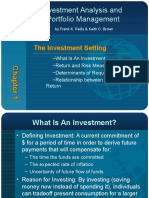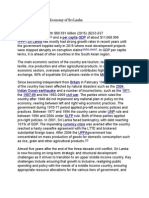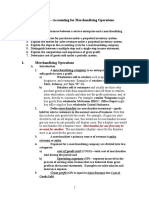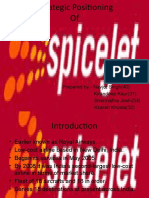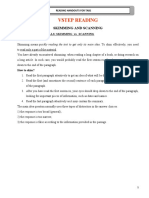Chapter 1 - The Investment Setting
Uploaded by
asmiChapter 1 - The Investment Setting
Uploaded by
asmiCHAPTER 1 - THE INVESTMENT SETTING
Rationale for Investment
Income streams and spending needs do not coincide
1. If income is greater than spending people tend to invest the surplus
2. If spending is greater than income people tend to borrow to cover the
deficit
B. People would be willing to forgo current consumption only if they can
achieve greater consumption in the future.
C. The rate of exchange between future consumption and present consumption
is the pure rate of interest. Market forces determine this rate.
D. Investment is the current commitment of funds for a period of time to obtain
a future flow of funds that will compensate the investor for the time the
funds are committed, for the expected rate of inflation, and for the
uncertainty of the future flow of funds.
II.
Measures of Return and Risk
A. Measures of Historical Rates of Return
1. Holding Period Return (HPR) - the total return from an investment,
including all sources of income, for a given period of time. A value of
1.0 indicates no gain or loss.
HPR
Ending Value of Investment (including cash flow during the holding period)
Beginning Value of Investment
2. Holding Period Yield (HPY) - the total return from an investment for a
given period of time stated as a percentage.
HPY = HPR - 1
Annual HPR = HPR1/n
where n is the number of years the investment is held
B. Computing Mean Historical Returns
1. Mean rate of return - the average of an investment's returns over time.
2. Single Investment
a. Arithmetic Mean (AM) - a measure of mean return equal to the sum
of annual returns divided by the number of years.
Arithmetic Mean = HPY/n
b. Geometric Mean (GM) - the nth root of the product of the annual
holding period returns for n years, minus one (1).
GM ={[HPR]1/n }- 1
where = the product of the annual holding period returns, i.e.,
(HPR)x(HPR2) x...(HPRn)
3. A Portfolio of Investments The mean historical rate of return for a
portfolio of investments is measured as the weighted average of the
HPYs for the individual investments in the portfolio.
C. Calculating Expected Rates of Return
1. Risk - the uncertainty that an investment will earn its expected rate of
return.
2. Probability the likelihood of an outcome
3. To compute the expected rate of return, the investor assigns probability
values to all possible returns. These probabilities range from zero (no
chance) to one (complete certainty).
4. Expected Return
Expected Return (Prob. of Return) x (Possible Return)
i 1
n
E(R i ) (Pi )(R i )
i 1
Risk aversion - the assumption that most investors will choose the
least risky alternative, all else being equal and that they will not
accept additional risk unless they are compensated in the form of
higher return.
Measuring the Risk of Expected Rates of Return
1. Variance - a measure of risk equal to the sum of the probability of return
times the squares of a return's deviation from the mean.
n
Variance (Prob.)(Possible Return - Expected Return) 2
i 1
n
2 (Pi )[R i - E(R i )]2
i 1
2. Standard Deviation () - a measure of risk equal to the square root of
variance.
3. Coefficient of variation (CV) - a measure of relative variability that
indicates risk per unit of return. It is used to compare alternative
investments whose rates of return and standard deviation vary widely.
CV
Standard Deviation of Returns
Expected Rate of Return
Determinants of Required Rates of Return
A. Rates of Return - vary over time and across investments (Exhibit 1.5).
B. The Real Risk-Free Rate (RRFR) - the basic interest rate assuming no
inflation or uncertainty.
1. Factors that influence this rate
A. Time preference for consumption of income
B. Investment opportunities in the economy.
2. This real risk-free rate is determined by the real growth rate of the
economy that is
impacted by growth rate of labor force, hours
worked, and rate of productivity
3. A positive relationship exists between the real growth rate in the economy
and the RRFR
C. The Nominal Risk-Free Rate (NRFR) incorporates inflation
1. Note the substantial variation in government T-bill rates over time
(Exhibit 1.6)
2. Factors that influence NRFR
A. Conditions in the Capital Markets - Relative ease or tightness (this is a
short-run phenomenon)
B. Expected Rate of Inflation - this is a major influence (Exhibit 1.6)
Nominal RRFR = (1 + RRFR)(1 + Expected Rate of Inflation) -1
RRFR
(1 Nominal RFR)
-1
(1 Rate of Inflation)
3. The Common Effect all factors discussed thus far affects all investments
equally irrespective of type or form.
D. Risk Premium varies from asset to asset and is responsible for differences
in rates of return between assets at a certain point in time. The major
determinants of the risk premium are:
1. Business risk uncertainty of income flows caused by the nature of a
firms business. Sales volatility and operating leverage determine the
level of business risk
2. Financial risk uncertainty caused by the use of debt financing
3. Liquidity risk - the inability to buy or sell an asset quickly with little price
change.
4. Exchange rate risk - the uncertainty of returns on securities acquired in a
foreign currency.
5. Country risk - uncertainty due to the possibility of major political or
economic change in the country where an investment has been made.
E. Risk Premium and Portfolio Theory
- The relevant risk measure for an individual asset is its comovement with
the market
portfolio
F. Fundamental Risk versus Systematic Risk
- Fundamental risk comprises business risk, financial risk, liquidity risk,
exchange rate risk, and country risk, while systematic risk refers to the
portion of an individual assets total variance attributable to the variability of
the total market portfolio
G. Required Rate of Return minimum acceptable rate of return from an
investment. Determined by RRFR, NRFR, and risk premium
IV.
Relationship between Risks and Return
A. Security Market Line (Exhibit 1.7)
B. Movements along the SML - A movement along the line indicates a change
in the level of risk for a given company or asset. (Exhibit 1.8)
C. Changes in the Slope of the SML - A change in the slope of the SML
indicates a change in the attitudes of investors toward risk--i.e., a change in
the required risk premium for a given asset or asset class. (Exhibit 1.10)
Shift in the SML (Exhibit 1.8)
Can be caused by a change in any of the following:
2. expected real growth in the economy
3. capital market conditions
4. expected rate of inflation.
E. Summary of Changes in the Required Rate of Return
You might also like
- Download Full (eBook PDF) Microeconomics 8th Edition by Jeffrey M. Perloff PDF All Chapters100% (1)Download Full (eBook PDF) Microeconomics 8th Edition by Jeffrey M. Perloff PDF All Chapters45 pages
- Investment Analysis and Portfolio Management: Frank K. Reilly & Keith C. Brown100% (2)Investment Analysis and Portfolio Management: Frank K. Reilly & Keith C. Brown48 pages
- Role of Commercial Banks in The Economic Development of Pakistan100% (2)Role of Commercial Banks in The Economic Development of Pakistan2 pages
- A Study On Financial Derivatives (Future and Option)0% (2)A Study On Financial Derivatives (Future and Option)56 pages
- Investment Analysis and Portfolio Management: Frank K. Reilly & Keith C. BrownNo ratings yetInvestment Analysis and Portfolio Management: Frank K. Reilly & Keith C. Brown56 pages
- BBMF3083 Portfolio Management: The Investment SettingNo ratings yetBBMF3083 Portfolio Management: The Investment Setting54 pages
- Investment Analysis and Portfolio Management 1No ratings yetInvestment Analysis and Portfolio Management 16 pages
- Investment Analysis and Portfolio Management: Lecture Presentation SoftwareNo ratings yetInvestment Analysis and Portfolio Management: Lecture Presentation Software48 pages
- The Investment Setting: Questions To Be AnsweredNo ratings yetThe Investment Setting: Questions To Be Answered58 pages
- Chapter 1-Overview of Investment ProcessNo ratings yetChapter 1-Overview of Investment Process55 pages
- Portfolio Management: Lecturer: Th.S. Le Phuoc Thanh (NCS)No ratings yetPortfolio Management: Lecturer: Th.S. Le Phuoc Thanh (NCS)47 pages
- Investment Analysis and Portfolio Management: Frank K. Reilly & Keith C. BrownNo ratings yetInvestment Analysis and Portfolio Management: Frank K. Reilly & Keith C. Brown48 pages
- Investment Analysis and Portfolio Management: Frank K. Reilly & Keith C. BrownNo ratings yetInvestment Analysis and Portfolio Management: Frank K. Reilly & Keith C. Brown48 pages
- Investment Analysis & Portfolio ManagementNo ratings yetInvestment Analysis & Portfolio Management27 pages
- Investment Analysis and Portfolio Management: Frank K. Reilly & Keith C. BrownNo ratings yetInvestment Analysis and Portfolio Management: Frank K. Reilly & Keith C. Brown48 pages
- Investment Analysis and Portfolio Management: Frank K. Reilly & Keith C. BrownNo ratings yetInvestment Analysis and Portfolio Management: Frank K. Reilly & Keith C. Brown42 pages
- Investment Analysis and Portfolio Management: Frank K. Reilly & Keith C. BrownNo ratings yetInvestment Analysis and Portfolio Management: Frank K. Reilly & Keith C. Brown48 pages
- Chapter 1 An Overview of The Investment ProcessNo ratings yetChapter 1 An Overview of The Investment Process31 pages
- Chapter 1 - The Investment Setting - UEFNo ratings yetChapter 1 - The Investment Setting - UEF56 pages
- Investment Analysis and Portfolio Management: Frank K. Reilly & Keith C. BrownNo ratings yetInvestment Analysis and Portfolio Management: Frank K. Reilly & Keith C. Brown48 pages
- Essentials of Investment Analysis and Portfolio ManagementNo ratings yetEssentials of Investment Analysis and Portfolio Management46 pages
- Chapter 1 (Continued) : Muhammad Khalid SohailNo ratings yetChapter 1 (Continued) : Muhammad Khalid Sohail29 pages
- Chapter 1 (Continued) : Muhammad Khalid SohailNo ratings yetChapter 1 (Continued) : Muhammad Khalid Sohail29 pages
- Solution Manual for Investment Analysis and Portfolio Management 10th Edition by Reilly - Fast Download To Start Reading Immediately100% (6)Solution Manual for Investment Analysis and Portfolio Management 10th Edition by Reilly - Fast Download To Start Reading Immediately41 pages
- Investment Analysis and Portfolio Managemnet by Frank K. Relly & Keith C. Brown01 Iapm9e PPT - ch01No ratings yetInvestment Analysis and Portfolio Managemnet by Frank K. Relly & Keith C. Brown01 Iapm9e PPT - ch0134 pages
- Investment - Arithmetic Mean (AM) : 1. Holding Period Return (HPR)No ratings yetInvestment - Arithmetic Mean (AM) : 1. Holding Period Return (HPR)3 pages
- Measures of Historical Rates of Return: Lesson 1: The Investment Setting What Is Investment?No ratings yetMeasures of Historical Rates of Return: Lesson 1: The Investment Setting What Is Investment?5 pages
- Capital Asset Pricing Model: Make smart investment decisions to build a strong portfolioFrom EverandCapital Asset Pricing Model: Make smart investment decisions to build a strong portfolio4.5/5 (3)
- Political Instability and Economic GrowthNo ratings yetPolitical Instability and Economic Growth1 page
- Pakistan-South Korea Relations: Trade LinksNo ratings yetPakistan-South Korea Relations: Trade Links3 pages
- Stakeholders, The Mission, Governance, and Business EthicsNo ratings yetStakeholders, The Mission, Governance, and Business Ethics29 pages
- Stakeholders, The Mission, Governance, and Business EthicsNo ratings yetStakeholders, The Mission, Governance, and Business Ethics29 pages
- The Fundamental Credit Analysis Approach Consists ofNo ratings yetThe Fundamental Credit Analysis Approach Consists of3 pages
- Customer Satisfaction Questionnaires: Agree Strongl y Agree Neutral Disagr Ee Strong Ly Disagr Ee 1No ratings yetCustomer Satisfaction Questionnaires: Agree Strongl y Agree Neutral Disagr Ee Strong Ly Disagr Ee 11 page
- Equal Employment Opportunities in PakistanNo ratings yetEqual Employment Opportunities in Pakistan8 pages
- Economy of Iran: Tehran Iran's IndustriesNo ratings yetEconomy of Iran: Tehran Iran's Industries6 pages
- Difference between the fundamental analysis and Technical AnalysisNo ratings yetDifference between the fundamental analysis and Technical Analysis1 page
- Chapter 5 Accounting For Merchandising OperationsNo ratings yetChapter 5 Accounting For Merchandising Operations15 pages
- Amity School of Architecture & Planning: Building Economics Lecture NotesNo ratings yetAmity School of Architecture & Planning: Building Economics Lecture Notes23 pages
- Parcor Quiz Manufacturing Operations Problem100% (1)Parcor Quiz Manufacturing Operations Problem1 page
- Income Statement: Presentation and LayoutsNo ratings yetIncome Statement: Presentation and Layouts4 pages
- Cost Allocation: Joint Products and ByproductsNo ratings yetCost Allocation: Joint Products and Byproducts32 pages
- Case - Report - Dollar - Tree Numbers PDFNo ratings yetCase - Report - Dollar - Tree Numbers PDF4 pages
- Various Pricing Strategies: A Review: Dr. Satyajeet S DeshpandeNo ratings yetVarious Pricing Strategies: A Review: Dr. Satyajeet S Deshpande5 pages
- Download Full (eBook PDF) Microeconomics 8th Edition by Jeffrey M. Perloff PDF All ChaptersDownload Full (eBook PDF) Microeconomics 8th Edition by Jeffrey M. Perloff PDF All Chapters
- Investment Analysis and Portfolio Management: Frank K. Reilly & Keith C. BrownInvestment Analysis and Portfolio Management: Frank K. Reilly & Keith C. Brown
- Role of Commercial Banks in The Economic Development of PakistanRole of Commercial Banks in The Economic Development of Pakistan
- A Study On Financial Derivatives (Future and Option)A Study On Financial Derivatives (Future and Option)
- Investment Analysis and Portfolio Management: Frank K. Reilly & Keith C. BrownInvestment Analysis and Portfolio Management: Frank K. Reilly & Keith C. Brown
- BBMF3083 Portfolio Management: The Investment SettingBBMF3083 Portfolio Management: The Investment Setting
- Investment Analysis and Portfolio Management: Lecture Presentation SoftwareInvestment Analysis and Portfolio Management: Lecture Presentation Software
- Portfolio Management: Lecturer: Th.S. Le Phuoc Thanh (NCS)Portfolio Management: Lecturer: Th.S. Le Phuoc Thanh (NCS)
- Investment Analysis and Portfolio Management: Frank K. Reilly & Keith C. BrownInvestment Analysis and Portfolio Management: Frank K. Reilly & Keith C. Brown
- Investment Analysis and Portfolio Management: Frank K. Reilly & Keith C. BrownInvestment Analysis and Portfolio Management: Frank K. Reilly & Keith C. Brown
- Investment Analysis and Portfolio Management: Frank K. Reilly & Keith C. BrownInvestment Analysis and Portfolio Management: Frank K. Reilly & Keith C. Brown
- Investment Analysis and Portfolio Management: Frank K. Reilly & Keith C. BrownInvestment Analysis and Portfolio Management: Frank K. Reilly & Keith C. Brown
- Investment Analysis and Portfolio Management: Frank K. Reilly & Keith C. BrownInvestment Analysis and Portfolio Management: Frank K. Reilly & Keith C. Brown
- Investment Analysis and Portfolio Management: Frank K. Reilly & Keith C. BrownInvestment Analysis and Portfolio Management: Frank K. Reilly & Keith C. Brown
- Essentials of Investment Analysis and Portfolio ManagementEssentials of Investment Analysis and Portfolio Management
- Solution Manual for Investment Analysis and Portfolio Management 10th Edition by Reilly - Fast Download To Start Reading ImmediatelySolution Manual for Investment Analysis and Portfolio Management 10th Edition by Reilly - Fast Download To Start Reading Immediately
- Investment Analysis and Portfolio Managemnet by Frank K. Relly & Keith C. Brown01 Iapm9e PPT - ch01Investment Analysis and Portfolio Managemnet by Frank K. Relly & Keith C. Brown01 Iapm9e PPT - ch01
- Investment - Arithmetic Mean (AM) : 1. Holding Period Return (HPR)Investment - Arithmetic Mean (AM) : 1. Holding Period Return (HPR)
- Measures of Historical Rates of Return: Lesson 1: The Investment Setting What Is Investment?Measures of Historical Rates of Return: Lesson 1: The Investment Setting What Is Investment?
- Capital Asset Pricing Model: Make smart investment decisions to build a strong portfolioFrom EverandCapital Asset Pricing Model: Make smart investment decisions to build a strong portfolio
- Stakeholders, The Mission, Governance, and Business EthicsStakeholders, The Mission, Governance, and Business Ethics
- Stakeholders, The Mission, Governance, and Business EthicsStakeholders, The Mission, Governance, and Business Ethics
- The Fundamental Credit Analysis Approach Consists ofThe Fundamental Credit Analysis Approach Consists of
- Customer Satisfaction Questionnaires: Agree Strongl y Agree Neutral Disagr Ee Strong Ly Disagr Ee 1Customer Satisfaction Questionnaires: Agree Strongl y Agree Neutral Disagr Ee Strong Ly Disagr Ee 1
- Difference between the fundamental analysis and Technical AnalysisDifference between the fundamental analysis and Technical Analysis
- Amity School of Architecture & Planning: Building Economics Lecture NotesAmity School of Architecture & Planning: Building Economics Lecture Notes
- Various Pricing Strategies: A Review: Dr. Satyajeet S DeshpandeVarious Pricing Strategies: A Review: Dr. Satyajeet S Deshpande









































